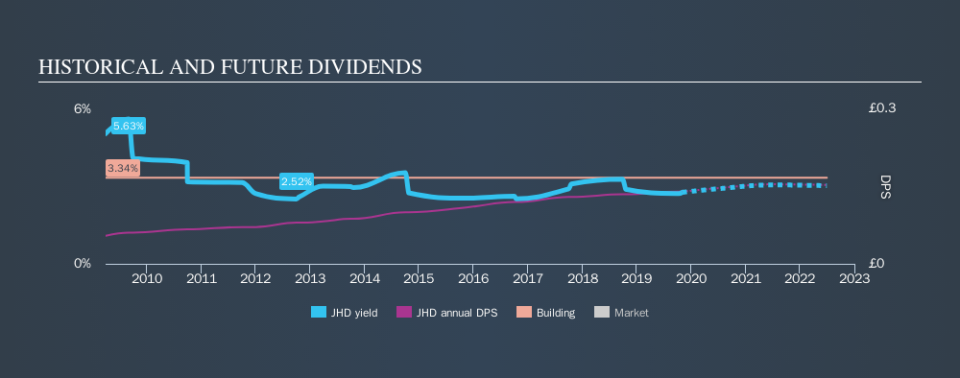Income Investors Should Know That James Halstead plc (LON:JHD) Goes Ex-Dividend Soon

Regular readers will know that we love our dividends at Simply Wall St, which is why it's exciting to see James Halstead plc (LON:JHD) is about to trade ex-dividend in the next 3 days. You will need to purchase shares before the 7th of November to receive the dividend, which will be paid on the 6th of December.
James Halstead's next dividend payment will be UK£0.1 per share, and in the last 12 months, the company paid a total of UK£0.1 per share. Last year's total dividend payments show that James Halstead has a trailing yield of 2.8% on the current share price of £5.04. Dividends are a major contributor to investment returns for long term holders, but only if the dividend continues to be paid. So we need to check whether the dividend payments are covered, and if earnings are growing.
See our latest analysis for James Halstead
Dividends are typically paid from company earnings. If a company pays more in dividends than it earned in profit, then the dividend could be unsustainable. Its dividend payout ratio is 77% of profit, which means the company is paying out a majority of its earnings. The relatively limited profit reinvestment could slow the rate of future earnings growth We'd be concerned if earnings began to decline. A useful secondary check can be to evaluate whether James Halstead generated enough free cash flow to afford its dividend. Over the last year it paid out 62% of its free cash flow as dividends, within the usual range for most companies.
It's positive to see that James Halstead's dividend is covered by both profits and cash flow, since this is generally a sign that the dividend is sustainable, and a lower payout ratio usually suggests a greater margin of safety before the dividend gets cut.
Click here to see the company's payout ratio, plus analyst estimates of its future dividends.
Have Earnings And Dividends Been Growing?
Stocks in companies that generate sustainable earnings growth often make the best dividend prospects, as it is easier to lift the dividend when earnings are rising. If earnings fall far enough, the company could be forced to cut its dividend. With that in mind, we're encouraged by the steady growth at James Halstead, with earnings per share up 3.6% on average over the last five years. A high payout ratio of 77% generally happens when a company can't find better uses for the cash. Combined with slim earnings growth in the past few years, James Halstead could be signalling that its future growth prospects are thin.
Another key way to measure a company's dividend prospects is by measuring its historical rate of dividend growth. James Halstead has delivered an average of 9.9% per year annual increase in its dividend, based on the past ten years of dividend payments. We're glad to see dividends rising alongside earnings over a number of years, which may be a sign the company intends to share the growth with shareholders.
To Sum It Up
From a dividend perspective, should investors buy or avoid James Halstead? Earnings per share have been growing modestly and James Halstead paid out a bit over half of its earnings and free cash flow last year. Overall, it's hard to get excited about James Halstead from a dividend perspective.
Ever wonder what the future holds for James Halstead? See what the two analysts we track are forecasting, with this visualisation of its historical and future estimated earnings and cash flow
We wouldn't recommend just buying the first dividend stock you see, though. Here's a list of interesting dividend stocks with a greater than 2% yield and an upcoming dividend.
We aim to bring you long-term focused research analysis driven by fundamental data. Note that our analysis may not factor in the latest price-sensitive company announcements or qualitative material.
If you spot an error that warrants correction, please contact the editor at editorial-team@simplywallst.com. This article by Simply Wall St is general in nature. It does not constitute a recommendation to buy or sell any stock, and does not take account of your objectives, or your financial situation. Simply Wall St has no position in the stocks mentioned. Thank you for reading.

 Yahoo Finance
Yahoo Finance 
